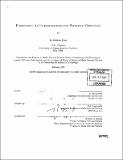| dc.contributor.advisor | Neil Gershenfeld. | en_US |
| dc.contributor.author | Post, E. Rehmi, 1966- | en_US |
| dc.contributor.other | Massachusetts Institute of Technology. Dept. of Architecture. Program In Media Arts and Sciences. | en_US |
| dc.date.accessioned | 2011-04-25T15:45:25Z | |
| dc.date.available | 2011-04-25T15:45:25Z | |
| dc.date.copyright | 1999 | en_US |
| dc.date.issued | 1999 | en_US |
| dc.identifier.uri | http://hdl.handle.net/1721.1/62351 | |
| dc.description | Thesis (S.M.)--Massachusetts Institute of Technology, School of Architecture and Planning, Program in Media Arts and Sciences, 1999. | en_US |
| dc.description | Includes bibliographical references (leaves 73-74). | en_US |
| dc.description.abstract | Wash-and-wear multilayer electronic circuitry can be constructed on fabric substrates, using conductive textiles and suitably packaged components. Fabrics are perhaps the first composite materials engineered by humanity; their evolution led to the development of the Jacquard loom, which itself led to the development of the modern computer. The development of fabric circuitry is a compelling closure of the cycle that points to a new class of textiles which interact with their users and their environments, while retaining the properties that made them the first ubiquitous "smart material". Fabrics are in several respects superior to existing flexible substrates in terms of their durability, conformability, and breathability. The present work adopts a modular approach to circuit fabrication, from which follow circuit design techniques and component packages optimized for use in fabric-based circuitry, flexible all-fabric interconnects, and multilayer circuits. While maintaining close compatibility with existing components, tools, and techniques, the present work demonstrates all steps of a process to create multilayer printed circuits on fabric substrates using conductive textiles. | en_US |
| dc.description.statementofresponsibility | by E. Rehmi Post. | en_US |
| dc.format.extent | 74 p. | en_US |
| dc.language.iso | eng | en_US |
| dc.publisher | Massachusetts Institute of Technology | en_US |
| dc.rights | M.I.T. theses are protected by
copyright. They may be viewed from this source for any purpose, but
reproduction or distribution in any format is prohibited without written
permission. See provided URL for inquiries about permission. | en_US |
| dc.rights.uri | http://dspace.mit.edu/handle/1721.1/7582 | en_US |
| dc.subject | Architecture. Program In Media Arts and Sciences. | en_US |
| dc.title | E-broidery : an infrastructure for washable computing | en_US |
| dc.title.alternative | Infrastructure for washable computing | en_US |
| dc.type | Thesis | en_US |
| dc.description.degree | S.M. | en_US |
| dc.contributor.department | Program in Media Arts and Sciences (Massachusetts Institute of Technology) | |
| dc.identifier.oclc | 48206827 | en_US |
